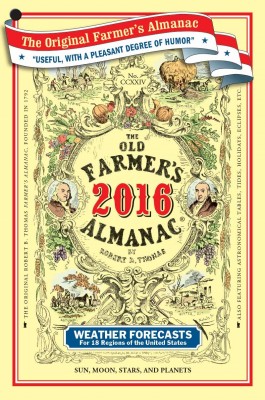 [1]Where I live in the Northeast, it is predicted that there will be a major snowstorm in the next few weeks. There also will be a full moon on Christmas Day. I am getting this information from the classic resource “The Old Farmer’s Almanac,” and by using it I also can offer up cooking tips for both fresh and comfort foods. Additionally, I can look up up natural remedies for the health problems you face.
[1]Where I live in the Northeast, it is predicted that there will be a major snowstorm in the next few weeks. There also will be a full moon on Christmas Day. I am getting this information from the classic resource “The Old Farmer’s Almanac,” and by using it I also can offer up cooking tips for both fresh and comfort foods. Additionally, I can look up up natural remedies for the health problems you face.
“The Old Farmer’s Almanac” has a long history and remains a great resource today, with its continued mission of being useful with a sense of humor. It has been around since 1792 and, in fact, was one of many almanacs of its day. It was published in 1792 by Robert B. Thomas during George Washington’s first term. (Its chief rival, “The Farmer’s Almanac,” is still around today, too.)
When “The Old Farmer’s Almanac” was first published, it cost six pence and was an immediate success. Its circulation went from 3,000 copies to 9,000 by its second year, and its primary early functions were forecasting weather and helping farmers know when they should plant crops.
In 1900, the almanac began to feature articles on nature and modern life. In this regard, it resembles more of what readers see today. It still contains long-term forecasts and advice for planting, along with homespun wisdom. Its iconic cover is the same, as is the hole in the upper left-hand cover that was strategically placed there so it could be hung in the outhouse for reading and other material.
How Does It Predict the Weather?
On the almanac’s website, the editors partially explain how they predict the weather. Their original founder, Robert B. Thomas, believed that weather was impacted by sunspots, and that solar patterns and past weather data could be used to determine future trends. Today, the “Old Farmer’s Almanac” has tweaked its forecasting formula.
4-Ounce Solar Survival Lantern Never Needs Batteries! [2]
Three scientific disciplines are used to make predictions, including: solar science (the study of sunspots and other solar activity), climatology (which examines established weather patterns), and meteorology (which examines atmospheric conditions). The exact formula that is used supposedly is kept secret in a black tin box at the almanac’s headquarters in Dublin, New Hampshire.
Four different regional versions are published in the U.S., in addition to a separate version for Canada.
While “The Old Farmer’s Almanac” boasts about an 80 percent accuracy rate, some farmers may dismiss it as not reliable enough. It may not be the first thing farmers or any long-term weather followers look to on a daily basis, but prior to modern weather forecasting, it was it! And it was accurate far more than it wasn’t.
With its advice on everything from canning and planning, to cooking and simple living, “The Old Farmer’s Almanac” is a resource that is still valued for its insights and homespun ideals. With both a book version and strong interactive website and tablet version, it remains very valuable and relevant today.
A 2011 poll [3] found that 80 percent of its readers buy it for its nature features, including weather and astronomy; 75 percent read it for cooking features; 74 percent for gardening features; and 72 percent for history features.
Today’s circulation numbers are around 3 million and Facebook likes are around 1 million — pointing to a continuous and strong presence in our culture today.
With its weather predictions, gardening tips, and folkloric appeal, it maintains a strong and popular place in our society.
How do you use the Old Farmer’s Almanac? Share your advice in the section below:
Learn Dozens Of All-Natural Gardening Secrets. Read More Here. [4]
